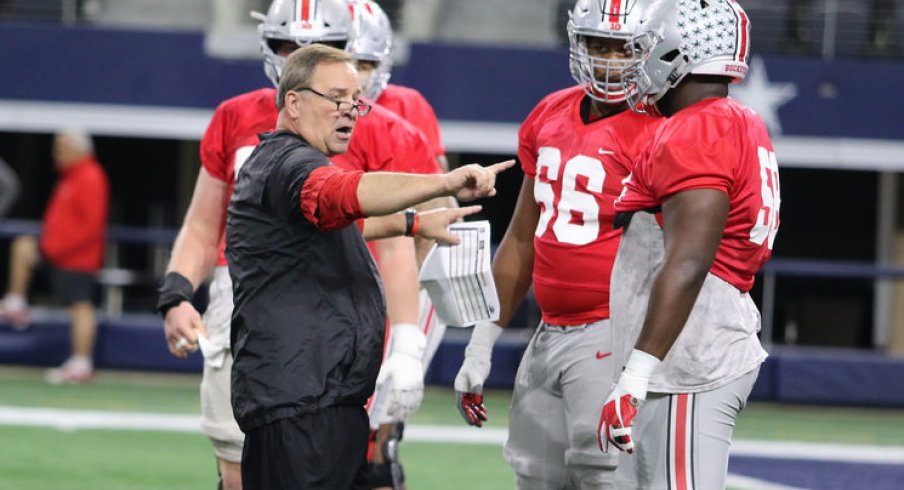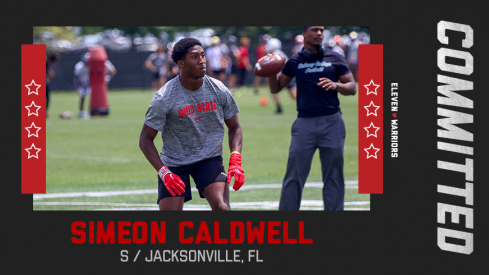Pass protection isn’t sexy.
99% of the time when a hotshot QB drops back to pass, all eyes are on him; not the big guys in front doing everything they can to keep their trigger man from being touched. No, his protectors often only get noticed in the relatively rare instance in which they fail to do their job correctly, either allowing the freaks of nature known as pass rushers to knock down the golden boy or committing a penalty while trying to prevent them from doing so.
Even as fans cheer at the commitments of blue-chip recruits like Wyatt Davis or Nicholas Petit-Frere commit, those same supporters will likely spend more collective time reading the commitment articles than they will actually watching those same players perform once they hit the field.
Film Study, sadly, has been no different. Despite spending countless hours dissecting the ups and downs of the Ohio State’s passing game over the past few years, rarely have the efforts of the Buckeye ‘Slobs’ up front been analyzed in this space.
However, as line coach Greg Studrawa and coordinator Kevin Wilson look to replace two stalwart starters in Rimington Trophy-winning center Billy Price and All-Big Ten left tackle Jamarco Jones this spring, it’s time to examine what, exactly, their replacements are being taught to perform when Dwayne Haskins, Joe Burrow, or Tate Martell drop back to pass.
As frequent observers of Urban Meyer’s offenses over the years may suspect, OSU’s pass protection schemes are far less diverse than those found in the running game. While Studrawa may be tasked with installing (at least) six core run-blocking schemes by the time the spring game rolls around (Tight Zone, Outside Zone, Split-Zone, Power, Counter-Trey, and Buck Sweep), they only have about half as many base protections to teach.
Going back to his days at Bowling Green and Utah, Meyer has long believed in relying primarily on five and six-man protection schemes. This matches his reliance on 11 personnel (1 back, 1 tight end), which looks to stretch the defense horizontally as well as vertically. If the defense brings more than six rushers, there should be at least one open receiver on a ‘hot’ route underneath and it’s on the quarterback to get the ball there quickly.
But those base, five and six-man protections still feature nuances of their own, as the pocket is split into halves. The Slide side features four linemen all stepping in the same direction and cutting off the gap to either their right or left, depending on the call. Opposite them is the Lock side, which asks the tackle to gain depth quickly and effectively lock on to that rusher in a one-on-one scenario, sealing that side of the pocket.
The calls themselves are quite simple. The five-man protection is called 50 or 51 in the huddle, with the second numeral signifying which side will be the Lock side (even = right, odd = left).
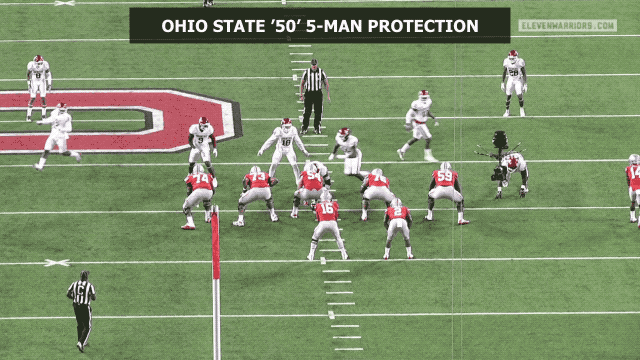
As one can easily see, the B-gap to the Lock side is vulnerable to pressure, which is why it’s up to the quarterback and/or the center to recognize pressure in that gap and flip the call before the snap. If both B-gaps are threatened, though, the Buckeyes will often call for six-man (60/61) protection.
When 60 or 61 is called, the running back joins the Lock side, reading inside-out while looking for additional blitzers. If none are present, the back can then release on a pass route.
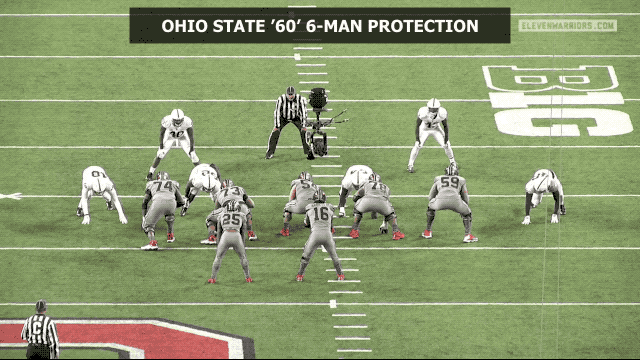
As seen in the clip above, the right guard initially steps to his left with the rest of the Slide side, but quickly reverses course to seal the B-gap. Unless a rusher had immediately come through that inside A-gap, the guard should take any rushing down linemen - regardless of gap - allowing the back to take on a far more manageable matchup like a blitzing linebacker or defensive back.
But when the defense shows a rusher in all the A and B-gaps, both the 50 and 60 series are left vulnerable, meaning a third option must be available. In 300/301 protection (the 3 signifying a quick, 3-step drop from the QB), all five linemen join the Slide side, as each is only responsible for the gap to either the right or the left, leaving the back to pick up any pressure off the otherwise unprotected edge.
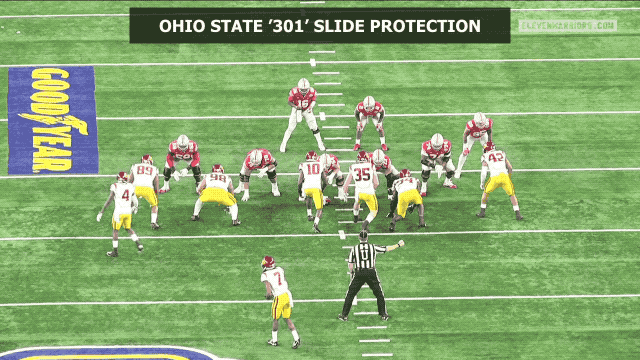
In this protection, the edge doesn’t have to be blocked by a traditional running back, as a tight end can also fill this responsibility, especially when in a Y-off alignment.
This doesn’t mean that there are only three protection schemes in the Buckeye playbook, as there are multiple sprint-out, waggle, and screen protections that may be added to a game plan from week to week. As you might expect, there is also a 70/71 series that keeps both the back and tight end in to help block when the offense expects a heavy rush.
However, the three protection schemes detailed above never come out of Ohio State’s game plans and will continue to act as the foundation for all of the Buckeyes’ dropback passes, no matter who lines up at left tackle, center, or yes, even at quarterback.
